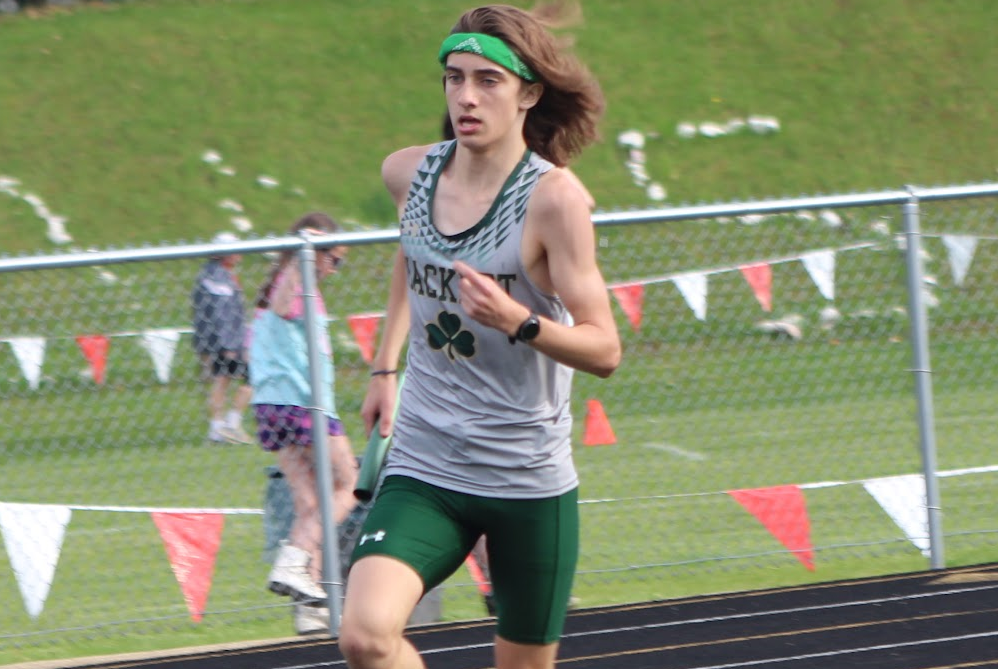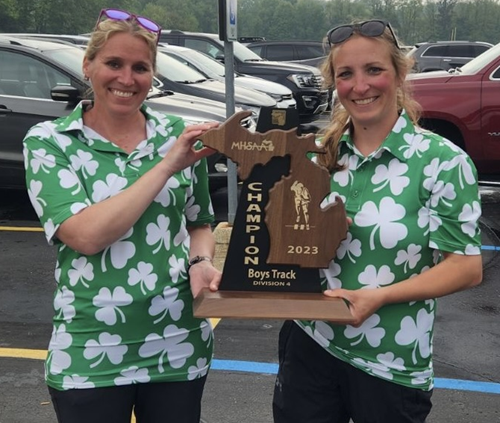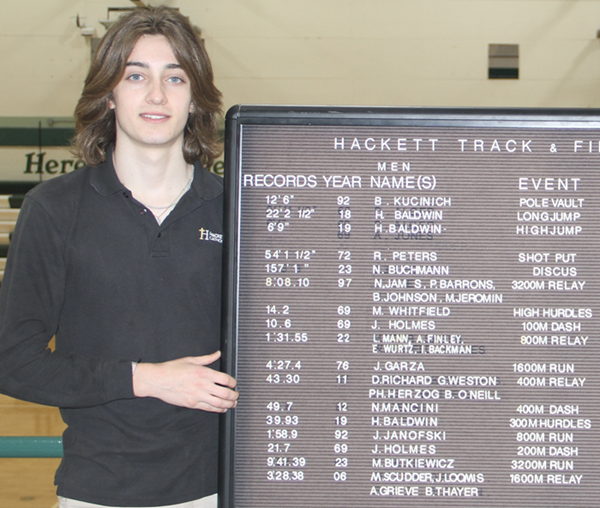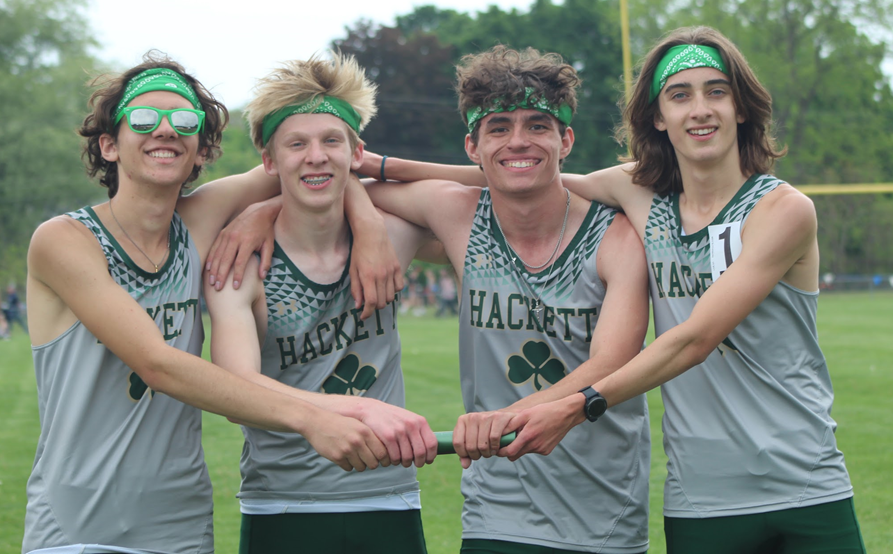
Hackett on Track to Roll Again with Distance Ace Among Those Leading Charge
By
Pam Shebest
Special for MHSAA.com
March 12, 2024
KALAMAZOO — After breaking one track record as a freshman, Marek Butkiewicz already has his eyes on two more.
 Not bad for a runner who did not even plan to run track during his years at Hackett Catholic Prep, a surprise to co-coach Shelly Germinder.
Not bad for a runner who did not even plan to run track during his years at Hackett Catholic Prep, a surprise to co-coach Shelly Germinder.
“I had heard plenty about him from some of the ultras (marathons) and different other races he had done,” Germinder said. "His commitment to the sport came through before we ever laid eyes on who he was. We knew he was going to be an asset to us.”
The current sophomore was not so sure.
“At the end of cross country (freshman year), I didn’t even think I wanted to do track,” Butkiewicz said. “Then I did it and it was ‘This is kind of fun.’
“I was good at it. I honestly didn’t have any desire going into (track season), and then I ran a couple fast times and I thought, ‘I can actually do this.’”
Butkiewicz said his freshman cross country season in 2022 was the first time he really took running seriously, and his interest was boosted when he ran a 17:31 at the Kalamazoo Christian Invitational.
“I was super happy to get the freshman record there,” he said.
This past season, Butkiewicz shattered Hackett’s sophomore cross country record, running a personal best 16:12.2 at the MHSAA Lower Peninsula Division 4 Final, demolishing the record set by Bryan Martin (16:56) in 2000.
That record also has special meaning to Germinder. Martin is her brother.
 The Irish finished in third place at the Final last fall, one point behind Holland Calvary Christian.
The Irish finished in third place at the Final last fall, one point behind Holland Calvary Christian.
With the start of the spring sports season this week, the Hackett boys are hoping to make it three Finals track & field titles in a row and five over six years.
Last year’s boys team made it a sweep, winning the Southwestern Athletic Conference, Regionals, MHSAA Finals and Michigan Interscholastic Track Coaches Association (MITCA) Team State Finals.
The boys and girls teams also earned MITCA Division 4 academic awards, the girls with a cumulative 3.986 GPA and the boys with a 3.909 GPA.
This year’s team has grown from a combined 54 athletes last year to 64 with 38 boys and 26 girls.
“I think the students as a whole are seeing the successes of the team, but I also think it’s some of the flexibility we have in our sport,” Germinder said. “We know there are kids who want a dual sport and want to be involved in other things, and we want that for them, too.
“In a small school, we can’t be successful if we don’t have kids involved in multiple sports because there just aren’t enough bodies.”
Co-coach Charissa Dean said this year’s boys team will have a different look.
“We lost Liam (Mann), who was a really strong sprinter, and he left some big shoes to fill,” she said. “We have a nice nest egg of freshmen and sophomores.
“We had a junior (Gabe Oeurn) last year who is coming into his own, if you look at his track record from freshman to sophomore to junior. Last year, we had Sam Finley who was a freshman, and a sophomore (Jude Coffman) who was first time out.”
Lofty goals
Butkiewicz’s goal is to break his own school 3,200-meter record plus the 1,600-meter record, currently held by Jose Garza (4:27.4 set in 1976).
He’s pursuing a 9.25 in the 3,200 and 4.20 in the 1,600, while his long-term goal is breaking four minutes, hopefully running at a Division I university.
“His dedication, his commitment,” Germinder said. “You can’t teach that. That’s something he does on his own that comes from within. Snow, rain, whatever it is, he’s out there running, no matter what.”
The sophomore said he had no clue about records when he was a freshman, but after turning in a 10:37 in his first 3,200, then 10:05 followed by a 10 flat, he realized a record was in reach.
Butkiewicz credits his dedication for his success.
“I put in hundreds of miles a month, thousands a year, just into grinding and working toward goals,” he said. “I’ll shoot for 40-45 (miles) in-season. Offseason, when I’m building my aerobic base, I want 50 and upwards.”
As a freshman, he found a running buddy in then-junior Gavin Sehy.
“He was the fastest for the past two years and I was a little ahead of him, so we just stuck with each other and trained together,” Butkiewicz said. “Over the winter we started doing a couple miles together.”
 Sehy, who is headed to Southwestern Michigan College in the fall, is shooting to break the school’s 800 record plus the 3,200 running with Nick Doerr, Alex Dumont and Butkiewicz.
Sehy, who is headed to Southwestern Michigan College in the fall, is shooting to break the school’s 800 record plus the 3,200 running with Nick Doerr, Alex Dumont and Butkiewicz.
Sehy was also a running buddy in cross country, finishing second on the team at 16:21.
“(Sehy) always had the potential, but it wasn’t until Marek came along that he started doing that training in the summer,” Dean said. “It has made a massive difference.”
Sehy and Butkiewicz competed in two ultramarathons (more than 26.2 miles) over the summer.
“I had never ran a marathon before, but somehow Marek convinced me to run 38 miles at Kettle Moraine State Forest (Wisconsin),” Sehy said. “And I did. Later in the summer, I ran 50 in Holly, Michigan.”
In the Wisconsin ultra, Butkiewicz was trying to finish the 100-mile run with Sehy pacing him for about 40 miles.
“I ended dropping at mile 75 because of some hip issues but he kept going and finished it,” Butkiewicz said. “The second one in Holly, I was doing 100 miles and he was doing 50, so we pretty much ran together for the first 50.”
Sehy said the two share the same mentality, which makes it easy to have a training buddy.
“We both really want it so bad, and we’re not afraid to do crazy things to get it,” he said. “Last year, during track, we needed to get some more miles in but just ran out of time during the week, so Sunday night we were out running 18 miles until after the sun went down out in the forest.”
Germinder said Sehy has noted he needs to have another runner to really push him.
“That’s one of the really beautiful things about the relationship they have,” she said. “It’s a healthy competition between them, but they want what’s best for each other, too.”
Butkiewicz lives near a land preserve where the two do much of their training, no matter what the weather, and they make it fun, jumping icy puddles and eating berries along the way.
“The coldest day of the year we ran with no shirts just because we could,” Sehy laughed.
When Sehy isn’t available to train, “I’ve been training a lot with Sean Siems; he’s a sophomore, a huge rising talent,” Butkiewicz said.
New year, new leaders
This year’s team will have a different look.
“We lost Liam and Bryce Brown and Nathan Buchmann (discus and only individual Finals champ),” Sehy said. “It’s tough to lose your best guys, but I think we have so much depth on this team, I think we’ll be all right.”
Just two weeks into the young season, Hackett will be on spring break, so many of the athletes pushed the coaches to schedule a meet before then.
 They found one in the Onsted Early Bird Meet on March 20.
They found one in the Onsted Early Bird Meet on March 20.
“They want to see where they are going into spring break to know, is there extra work we need to do during spring break,” Germinder said. “Having a competition will tell them where they’re at.
“If you do nothing (over spring break), then you’re starting all over again. I think a lot of our athletes recognize that and know they have to work a little more.”
Besides Butkiewicz and Sehy, leaders on the team include pole vaulters/sprinters Jack Prom and Lauren Wild.
“Keegan Gallagher is our biggest cheerleader and keeps the team in good spirits,” Germinder added. “He brings something that isn’t just on the track.”
With such large numbers, “If they’re not competing, we like to take them with us on the bus anyway,” Dean said. “They can help support their teammates, they can run a stopwatch, they can take video of the relay handoffs so we can go back and look at it later.”
In spite of the success on the track or in the field, Germinder said she is most proud of the athletes as people.
“With that leadership comes responsibility of good sportsmanship, how they’re interacting with other teams on the line,” she said. “I love watching our boys praying together with other teams before they’re getting ready to run. Or shaking hands before or after, especially sprinting events. It says a lot about who we are.”
 Pam Shebest served as a sportswriter at the Kalamazoo Gazette from 1985-2009 after 11 years part-time with the Gazette while teaching French and English at White Pigeon High School. She can be reached at [email protected] with story ideas for Calhoun, Kalamazoo and Van Buren counties.
Pam Shebest served as a sportswriter at the Kalamazoo Gazette from 1985-2009 after 11 years part-time with the Gazette while teaching French and English at White Pigeon High School. She can be reached at [email protected] with story ideas for Calhoun, Kalamazoo and Van Buren counties.
PHOTOS (Top) Kalamazoo Hackett Catholic Prep’s Marek Butkiewicz rounds a curve during a race last season. (2) Butkiewicz shows the school record board, including his 3,200 entry earned last season. (3) Hackett track coaches Charissa Dean, left, and Shelly Germinder hold up last season’s MHSAA Finals championship trophy. (4) The Hackett 3,200 relay, from left: Gavin Sehy, Alex Dumont, Nick Doerr and Butkiewicz. (Action, coaches and relay photos courtesy of the Kalamazoo Hackett Catholic Prep boys track & field program; record board photo by Pam Shebest.)

Hastings Relays Reigns as State's Oldest Continuous Track & Field Meet
By
Steve Vedder
Special for MHSAA.com
April 10, 2024
Bob Branch remembers dabbling in other sports, but his first love was always running.
 The Hastings High School graduate admits he could never hit a baseball, football didn't especially appeal to him and basketball was just another way to spend time with friends. But for Branch, now 93, there was always track. That's the sport where his fondest and sharpest memories remain. And if you're talking track, many of his favorite memories come from participation in the state's oldest continuous track meet, the Hastings Relays.
The Hastings High School graduate admits he could never hit a baseball, football didn't especially appeal to him and basketball was just another way to spend time with friends. But for Branch, now 93, there was always track. That's the sport where his fondest and sharpest memories remain. And if you're talking track, many of his favorite memories come from participation in the state's oldest continuous track meet, the Hastings Relays.
Always held in early April, the meet dates back to 1937 – a bygone time that saw the first hostilities of World War II, gas at 20 cents a gallon and a loaf of bread selling for a dime.
And at a dusty old track surrounding the county fairgrounds in Hastings, a small relay event that included a scattering of participants from a dozen high schools was taking its first tentative steps.
Branch recalls a time when kids would run home after track practice because there were no buses, inexperienced young coaches had little actual knowledge of running fundamentals, and athletes looked at the sport as an afterthought after spending most of their high school days playing football and basketball.
 For Branch, the relays were the ideal way to ease into the track season.
For Branch, the relays were the ideal way to ease into the track season.
"I just liked to run," said Branch. "I remember I anchored a relay with my brother, and it always seemed cold when we had that meet. I remember teams would come from all over and you saw a lot of good athletes. Everybody seemed to have someone who was really good. Track wasn't very popular at that time, but I have a lot of good memories from running."
The Hastings Relays, which has changed formats and even names during its nearly nine-decade history, would traditionally kick off the track season. The meet was originally held at a makeshift quarter-mile track which surrounded the town's fairgrounds and was part of the city's annual Hastings Carnival – the track would become the midway during fair time.
The meet eventually moved to Johnson Field when the football field was dedicated in 1949 and ballooned to as many as 50 teams at its peak in 1957. For more than seven decades it was known as the Hastings Relays and then the Hastings Co-Ed relays before becoming the current Hastings Invitational, with the latest edition scheduled for Friday.
Johnson Field had a cinder track before it became an all-weather surface in the 1980s. During a time long before computers would be used to organize meet heats in mere minutes, Hastings coaches of all sports – defined as "volunteers" by the athletic department – would meet on the Friday before competition to hash out events.
People associated with the meet still recall the camaraderie built on those long Friday nights, followed by working what would often become 10-hour meets. Steve Hoke has been involved since watching his father, Jack, who coached teams at 15 of the meets beginning in 1951 and also had run in the first Hastings Relays. Steve Hoke later competed in the Relays as well during the early 1970s before becoming an assistant track coach, later the Hastings athletic director and now a volunteer worker.
"It was always a huge deal," said Hoke, who said the meet began as a pure relay event before transitioning to its current team format in the 1990s. "I remember we'd line the track the night before, and all the coaches would come to the house to organize everything. There was a brotherhood.”
 If you quiz many of the fleet of volunteers who've worked the relays over the years, each has a different memory from the meet. While Hoke describes the brotherhood and Branch the outstanding competition, others remember weather and the time a thunderstorm wiped out the line markings on the cinder track, or waking up to find three inches of snow that caused a rare cancellation of the meet. Others recall the shock of moving from the cinder to all-weather track or using the meet as an early measuring stick of what it would take to qualify for the state meet. The real old-timers remember the meet disappearing for three years during World War II.
If you quiz many of the fleet of volunteers who've worked the relays over the years, each has a different memory from the meet. While Hoke describes the brotherhood and Branch the outstanding competition, others remember weather and the time a thunderstorm wiped out the line markings on the cinder track, or waking up to find three inches of snow that caused a rare cancellation of the meet. Others recall the shock of moving from the cinder to all-weather track or using the meet as an early measuring stick of what it would take to qualify for the state meet. The real old-timers remember the meet disappearing for three years during World War II.
Hastings native and Western Michigan grad Tom Duits was the state’s second collegian to break the four-minute mile when he ran a 3:59.2 at a meet in Philadelphia in 1978. Duits, who ran in three Hastings Relays, was in line to join the U.S. Olympic team in 1980 before the United States pulled out of the games due to tension with Russia.
Duits has his own memories of the meet and the competition he faced there.
"I remember sunshine and being excited to be competing again. There were all these athletes swarming around; it was an awesome display of talent," he said. "It was always one of the best meets we'd be in. You could pretty much see the level of runners who would be at state, which made it a big deal. It was always early, but you could tell where you stood. It was great exposure."
Hastings track star Wayne Oom competed in four Hastings Relays from 1984-87. One of his sharpest memories was the difference between running on a raw cinder track versus the far more comfortable all-weather surface.
"Those cinders would grind into your skin," said Oom, part of the Hastings school record in the two-mile relay. "But I think it helped us because when we'd go to other tracks, it seemed we would run faster. I remember how competitive it was, especially in the distances. There were some great runners."
While participants have their unique memories, so do coaches. Former Saxons coach Paul Fulmer remembers 2008 when his team finished first on the boys side of the meet while his wife, Grand Haven coach Katie Kowalczyk-Fulmer, saw her girls team win the championship.
 "I knew we were one of the favorites to win because we were usually near the top of our conference and Regional," he said. "But then Katie's team was pretty good, and it was cool for them to win too."
"I knew we were one of the favorites to win because we were usually near the top of our conference and Regional," he said. "But then Katie's team was pretty good, and it was cool for them to win too."
Fulmer, who coached Hastings from 1978-81 and then 1985-2010, said at least part of the meet's popularity was derived from a unique way of scoring. Instead of individuals earning points solo, participants worked in pairs. For instance, two athletes would combine their shot put or long jump scores. New events such as the 1,500 relay and sprint medley were added.
"We had a tradition of being the state's oldest meet, and that was a big deal," Fulmer said. "And we ran a good relay; that attracted teams too. We took a lot of pride in that.
"And we'd get quite a lot of people to come to the meet. We'd set up until like 9 or 10 p.m., and then we'd have a party with all the coaches on Friday night."
While the meet has stretched 87 years, Branch said early participants and current runners have one thing in common: a drive to win. Branch ran in an era when the popularity of high school track was in its infancy. Today some of the best all-around athletes at a school are involved in the track program. The relays span the nearly nine decades in between.
"The quality of teams has gotten better and better," said Branch, the 1947 Lower Peninsula Class B Finals champ in the 220. "And this has made for a better meet. We would get guys who played football or baseball kind of drift into track, and that made the sport better. I think people began to appreciate track because we'd get teams from all over.
"We went from not really knowing what we were doing to track being a good sport. Even then, I'm not sure we appreciated what we had. We really liked the Hastings Relays and always wanted to do well there. It became popular and quite an honor to do well. Those are the kind of things I remember."
PHOTOS (Top) Racers run at the Hastings Relays, with several more awaiting their turns to compete at the longtime meet. (2) The author wrote on the 50th anniversary of the Relays for the Hastings Banner nearly 40 years ago. (3) Past athlete, coach and athletic director Steve Hoke shows some of the Relays awards from the 1930s. (4) Tom Duits was one of the state’s biggest track stars of the 1970s and ran in three Hastings Relays. (Top photo by Dan Goggins, Hoke photo provided by Steve Hoke and Duits photos provided by Tom Duits.)

